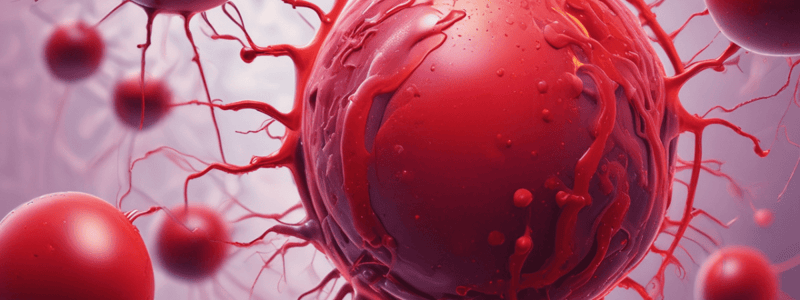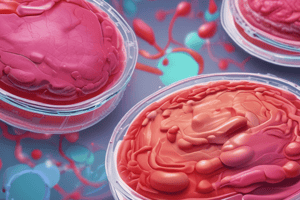Podcast
Questions and Answers
Which of the following is NOT a common cause of a prolonged prothrombin time (PT)?
Which of the following is NOT a common cause of a prolonged prothrombin time (PT)?
- Acquired inhibitor of the extrinsic pathway
- Deficiency of fibrinogen
- Deficiency of von Willebrand factor (correct)
- Deficiency of factor VII
A patient presents with a platelet count of 80,000/μL, easy bruising, and epistaxis that takes a long time to stop. Which of the following is the most likely diagnosis?
A patient presents with a platelet count of 80,000/μL, easy bruising, and epistaxis that takes a long time to stop. Which of the following is the most likely diagnosis?
- Von Willebrand disease
- Immune thrombocytopenic purpura (ITP) (correct)
- Hemophilia A
- Disseminated intravascular coagulation (DIC)
Which of the following is the most common hereditary coagulation disorder?
Which of the following is the most common hereditary coagulation disorder?
- Hemophilia A
- Disseminated intravascular coagulation (DIC)
- Immune thrombocytopenic purpura (ITP)
- Von Willebrand disease (correct)
A patient has a normal platelet count, slightly prolonged partial thromboplastin time (PTT), and decreased von Willebrand factor antigen levels. Which of the following is the most likely diagnosis?
A patient has a normal platelet count, slightly prolonged partial thromboplastin time (PTT), and decreased von Willebrand factor antigen levels. Which of the following is the most likely diagnosis?
Which of the following is the most common cause of acquired coagulation disorders?
Which of the following is the most common cause of acquired coagulation disorders?
A patient presents with excessive bleeding after a minor injury, prolonged nosebleeds, and heavy menstrual periods. Which laboratory test would be the most helpful in diagnosing the underlying condition?
A patient presents with excessive bleeding after a minor injury, prolonged nosebleeds, and heavy menstrual periods. Which laboratory test would be the most helpful in diagnosing the underlying condition?
Which of the following is NOT a common trigger for disseminated intravascular coagulation (DIC)?
Which of the following is NOT a common trigger for disseminated intravascular coagulation (DIC)?
A patient has a normal platelet count, prolonged prothrombin time (PT), and prolonged partial thromboplastin time (PTT). Which of the following is the most likely cause?
A patient has a normal platelet count, prolonged prothrombin time (PT), and prolonged partial thromboplastin time (PTT). Which of the following is the most likely cause?
Which of the following is the most common symptom of immune thrombocytopenic purpura (ITP)?
Which of the following is the most common symptom of immune thrombocytopenic purpura (ITP)?
A patient with known von Willebrand disease is scheduled for a surgical procedure. Which of the following treatments would be the most appropriate to prevent excessive bleeding?
A patient with known von Willebrand disease is scheduled for a surgical procedure. Which of the following treatments would be the most appropriate to prevent excessive bleeding?
Which of the following pathways is activated by negatively charged surfaces, such as polyphosphates?
Which of the following pathways is activated by negatively charged surfaces, such as polyphosphates?
Which laboratory test is used to evaluate the intrinsic and common coagulation pathways?
Which laboratory test is used to evaluate the intrinsic and common coagulation pathways?
Which of the following is a common symptom of severe thrombocytopenia (low platelet count)?
Which of the following is a common symptom of severe thrombocytopenia (low platelet count)?
Which coagulation factor is deficient in von Willebrand disease, a common inherited bleeding disorder?
Which coagulation factor is deficient in von Willebrand disease, a common inherited bleeding disorder?
Which of the following events marks the start of the common coagulation pathway, leading to the formation of cross-linked fibrin clots?
Which of the following events marks the start of the common coagulation pathway, leading to the formation of cross-linked fibrin clots?
Which component of normal clotting is activated by TF released during vascular injury?
Which component of normal clotting is activated by TF released during vascular injury?
What initiates the intrinsic pathway, also known as the 'contact activation pathway'?
What initiates the intrinsic pathway, also known as the 'contact activation pathway'?
Which factor marks the start of the common coagulation pathway leading to cross-linked fibrin clot formation?
Which factor marks the start of the common coagulation pathway leading to cross-linked fibrin clot formation?
Which component is not depicted in the schematic but is activated upon injury?
Which component is not depicted in the schematic but is activated upon injury?
What triggers the conversion of inactive coagulation factors to their active form in the blood coagulation cascade?
What triggers the conversion of inactive coagulation factors to their active form in the blood coagulation cascade?
Which of the following antimalarial medications is known to be associated with the development of immune thrombocytopenic purpura (ITP)?
Which of the following antimalarial medications is known to be associated with the development of immune thrombocytopenic purpura (ITP)?
A patient is taking the antiepileptic medication $carbamazepine$ and presents with easy bruising and prolonged nosebleeds. Which of the following is the most likely explanation for these symptoms?
A patient is taking the antiepileptic medication $carbamazepine$ and presents with easy bruising and prolonged nosebleeds. Which of the following is the most likely explanation for these symptoms?
A patient taking the anti-inflammatory medication $ibuprofen$ presents with a low platelet count and petechial rash. Which of the following is the most likely explanation for these findings?
A patient taking the anti-inflammatory medication $ibuprofen$ presents with a low platelet count and petechial rash. Which of the following is the most likely explanation for these findings?
A patient develops thrombocytopenia and easy bruising after receiving the $pneumococcal vaccine$. Which of the following is the most likely explanation for these symptoms?
A patient develops thrombocytopenia and easy bruising after receiving the $pneumococcal vaccine$. Which of the following is the most likely explanation for these symptoms?
A patient taking the antiepileptic medication $phenytoin$ presents with a prolonged prothrombin time (PT) and partial thromboplastin time (PTT). Which of the following is the most likely explanation for these laboratory findings?
A patient taking the antiepileptic medication $phenytoin$ presents with a prolonged prothrombin time (PT) and partial thromboplastin time (PTT). Which of the following is the most likely explanation for these laboratory findings?
A patient taking the antimycobacterial medication $rifampicin$ develops easy bruising and prolonged nosebleeds. Which of the following is the most likely explanation for these symptoms?
A patient taking the antimycobacterial medication $rifampicin$ develops easy bruising and prolonged nosebleeds. Which of the following is the most likely explanation for these symptoms?
A patient taking the antiepileptic medication $sodium valproate$ presents with a low platelet count and petechial rash. Which of the following is the most likely explanation for these findings?
A patient taking the antiepileptic medication $sodium valproate$ presents with a low platelet count and petechial rash. Which of the following is the most likely explanation for these findings?
A patient develops thrombocytopenia and easy bruising after receiving the $influenza vaccine$. Which of the following is the most likely explanation for these symptoms?
A patient develops thrombocytopenia and easy bruising after receiving the $influenza vaccine$. Which of the following is the most likely explanation for these symptoms?
A patient taking the antimalarial medication $chloroquine$ presents with a normal platelet count but prolonged prothrombin time (PT) and partial thromboplastin time (PTT). Which of the following is the most likely explanation for these laboratory findings?
A patient taking the antimalarial medication $chloroquine$ presents with a normal platelet count but prolonged prothrombin time (PT) and partial thromboplastin time (PTT). Which of the following is the most likely explanation for these laboratory findings?
A patient taking the antiepileptic medication $ethambutol$ develops easy bruising and prolonged nosebleeds. Which of the following is the most likely explanation for these symptoms?
A patient taking the antiepileptic medication $ethambutol$ develops easy bruising and prolonged nosebleeds. Which of the following is the most likely explanation for these symptoms?
Flashcards are hidden until you start studying



